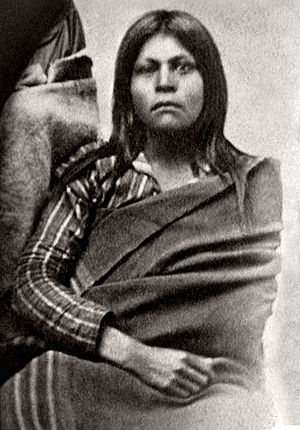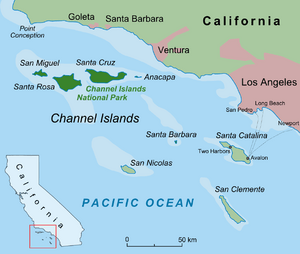Juana Maria facts for kids
Quick facts for kids
Juana Maria
|
|
|---|---|

A Native American woman believed to be Juana Maria
|
|
| Born | Before 1811 |
| Died | October 19, 1853 |
| Known for | Inspiring the book and short movie Island of the Blue Dolphins |
Juana Maria was a brave Native Californian woman. She is famous for living alone on a remote island for 18 years! Her real Native American name is unknown. She was the last person from her tribe, the Nicoleño people. Her amazing story inspired the popular children's book Island of the Blue Dolphins.
Contents
The Island Home
The Channel Islands have been home to people for a very long time. Native Americans lived there over 10,000 years ago! When Europeans first arrived, two main groups lived on the islands. The Chumash lived on the northern islands. The Tongva lived on the southern islands. Juana Maria's tribe, the Nicoleño, were related to the Tongva people.
In the early 1540s, a Spanish explorer named Juan Rodríguez Cabrillo explored the California coast. He claimed the land for Spain. San Nicolas Island is a dry, mostly empty island. It is about 60 miles from the California coast.
Left Behind
In 1814, a ship brought a group of Native Alaskan otter hunters to the island. These hunters worked for a Russian company. They had a fight with the islanders and many Nicoleño people were killed.
Later, in 1835, a ship called the Peor es Nada came to San Nicolas Island. Its job was to take the remaining Nicoleño people to the mainland. This was to protect them and move them to missions. The ship's crew gathered the islanders on the beach. They brought them onto the ship.
But Juana Maria was not among them. A big storm suddenly started. The ship's crew got scared that their ship would crash. They quickly sailed away to the mainland, leaving Juana Maria behind.
Some stories say Juana Maria jumped off the ship. She supposedly did this when she realized her younger brother was left behind. But this story might not be true. It appeared much later, and the person who rescued her, George Nidever, said he might have misremembered it.
Discovery and Rescue
For many years, people tried to find Juana Maria. Father José González Rubio from the Santa Barbara Mission offered money to find her. One man, Thomas Jeffries, tried but failed. However, his stories made a fur trapper named George Nidever curious.
Nidever launched his own search expeditions. His first two tries did not find her. But on his third try in 1853, one of his men found human footprints on the beach. They also found pieces of seal blubber left out to dry.
They searched further and found Juana Maria. She was living in a simple hut made partly of whale bones. She wore a skirt made of green cormorant bird feathers. People also believed she lived in a nearby cave sometimes.
After her discovery, Juana Maria was taken to the Santa Barbara Mission. But no one there could understand her language. The local Chumash Indians could not understand her. Even a group of Tongva people from another island could not understand her.
Scientists later studied the few words and songs recorded from Juana Maria. They believe she spoke a language similar to the Luiseño or Acjachemen languages. These tribes traded with the San Nicolas islanders. This suggests Juana Maria was indeed a native Nicoleño.
Life at the Mission
Juana Maria was very excited when she arrived at the mission. She was amazed by horses, European clothes, and new foods. She stayed with George Nidever. He described her as a woman of "medium height, but rather thick." He thought she was about 50 years old, but still strong. He said her face was always smiling.
Juana Maria seemed to enjoy visitors. She would sing and dance for the people of Santa Barbara. One of her songs is called the "Toki Toki" song. A man named Malquiares, who was on Nidever's expedition, heard her sing it. He later shared the words with his friend Fernando Librado.
The song's words are:
Toki Toki yahamimena (×3)
weleshkima nishuyahamimena (×2)
Toki Toki ... (continue as above)

One translation of the song means, "I live contented because I can see the day when I want to get out of this island." However, this translation might not be fully accurate.
Her Final Days
Sadly, Juana Maria died just seven weeks after arriving on the mainland. She died from dysentery, a severe illness. Nidever thought she got sick from eating too much green corn, vegetables, and fresh fruit. She had not eaten such foods for many years on the island.
Before she died, a priest named Father Sanchez baptized her. He gave her the Spanish name Juana Maria. She was buried in an unmarked grave at the Santa Barbara Mission cemetery. In 1928, a plaque was placed there to remember her.
Many of Juana Maria's belongings were brought from the island. These included her water basket, clothes, and bone needles. They were kept at the California Academy of Sciences. But they were destroyed in the 1906 San Francisco earthquake and fire. Her special cormorant feather dress was sent to the Vatican, but it seems to have been lost.
What We Found
In 1939, archaeologists found Juana Maria's whale-bone hut on San Nicolas Island. Its location matched Nidever's descriptions perfectly. In 2012, another archaeologist found a site that might have been Juana Maria's cave.
In 2009, archaeologists found two redwood boxes from the Nicoleño people. They were covered by a whale rib. Inside were over 200 artifacts. These included bird-bone pendants, shell dishes, fish hooks, and stone ornaments. They also found glass and metal items. These findings help us learn more about the Nicoleño people and Juana Maria's life.
Her Legacy
Scott O'Dell's famous book Island of the Blue Dolphins was inspired by Juana Maria's story. The main character, Karana, faces many challenges. These are similar to what Juana Maria might have experienced alone on San Nicolas Island. In the 1964 movie based on the book, Celia Kaye played Karana.
Images for kids
See also
 In Spanish: Juana Maria para niños
In Spanish: Juana Maria para niños






